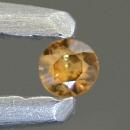|
|
||||||||||||||||
|
||||||||||||||||
|
||||||
|
|
|
|
Hibonite
|
|
| | |
| Discovered in 1956; IMA status: Valid (pre-IMA; Grandfathered) | ||
|
| ||
|
Chemistry |
|
|
| |
|
(Ca,Ce,La)(Al,Ti,Mg,Fe)12O19 | |
|
|
Calcium Cerium Lanthanum Aluminum Titanium Magnesium Iron Oxide |
|
Molecular Weight: |
708.81 gm |
|
Composition: |
Calcium |
4.52 % |
Ca |
6.33 % |
CaO |
|
|
Lanthanum |
1.96 % |
La |
2.30 % |
La2O3 |
|
|
Cerium |
1.98 % |
Ce |
2.32 % |
Ce2O3 |
|
|
Magnesium |
0.17 % |
Mg |
0.28 % |
MgO |
|
|
Titanium |
3.38 % |
Ti |
5.63 % |
TiO2 |
|
|
Aluminum |
39.59 % |
Al |
74.80 % |
Al2O3 |
|
|
Iron |
5.52 % |
Fe |
7.10 % |
FeO |
|
|
Oxygen |
42.89 % |
O |
|
|
|
|
|
100.00 % |
|
98.76 % |
= TOTAL OXIDE |
|
|
|
||||
|
Classification |
|
|
| |
|
Oxides | |
|
4/C.08-30 | |
|
|
4 : OXIDES (Hydroxides, V[5,6] vanadates, arsenites, antimonites, bismuthites, sulfites, selenites, tellurites, iodates)
|
|
Related to: |
Magnetoplumbite (Plumboferrite) Group |
|
Members of Group: |
Magnetoplumbite Group: Barioferrite, Batiferrite, Haggertyite, Hawthorneite, Hibonite, IMA2009-027, Magnetoplumbite, Nežilovite, Plumboferrite, Yimengite |
|
Varieties: |
None |
|
Synonyms: |
None |
|
|
|
|
Crystal Data |
|
|
|
|
|
Prisms, platy on {0001}, or steep pyramidal, to 4 cm, showing six sectors on {0001}. |
|
|
None |
|
|
|
|
|
Physical Properties |
|
|
|
|
|
Good on {0001}; parting on {1010} |
|
|
Sub-Conchoidal |
|
|
Brittle |
|
|
7.5 - 8.0 |
|
|
3.84 (g/cm3) |
|
|
Not Fluorescscent |
|
|
Mild; GRapi = 4,081.56 (Gamma Ray American Petroleum Institute Units) |
|
|
|
|
|
Optical Properties |
|
|
|
|
|
Brownish black to black; reddish brown in thin fragments; blue in meteorites. |
|
|
Semitransparent to Opaque |
|
|
Vitreous |
|
|
1.790 - 1.807 Uniaxial ( - ) |
|
|
0.00 |
|
|
n/a |
|
|
O = brownish gray; E = gray |
|
|
|
|
|
Occurances |
|
|
|
|
|
Geological Setting: |
In metamorphosed limestone, pyroxenite, gneiss, and granulite of the amphibolite to granulite facies; also alluvial. A common accessory in Ca–Al-rich inclusions in some carbonaceous chondrites. |
|
Common Associations: |
Calcic Plagioclase, Corundum, Spinel, Thorianite, Titanite (Esiva, Madagascar); Anorthite, Grossular, Titanite, Zoisite, Clinozoisite (Mahenge, Tanzania); Vesuvianite, Hercynite, Corundum, Andalusite, Kyanite, Diopside, Rutile, Titanite, Magnetite (Shoriya Mountains, Russia). |
|
Common Impurities: |
Fe, Si |
|
Type Locality: |
Esiva eluvials, Maromby Commune, Amboasary District, Anosy Region (Fort Dauphin Region), Tuléar Province (Toliara), Madagascar |
|
Year Discovered: |
1956 |
|
View mineral photos: | |
|
|
|
|
More Information |
|
|
|
|
|
| |
|
|
|
|
Hibonite was named after Paul Hibon who discovered the mineral in the Esiva eluvials, Amboasary District, Anosy Region (Fort Dauphin Region), Tuléar Province, Madagascar in 1956. Hibonite is closely related to Hibonite-Fe (IMA 2009-027) an alteration mineral from the Allende meteorite. The Allende meteorite is the largest carbonaceous chondrite ever found on Earth. The meterorites fall to Earth was witnessed on February 8, 1969, falling over the Mexican state of Chihuahua near Pueblito de Allende. After breaking up in the atmosphere, an extensive search for pieces was conducted and it is often described as "the best-studied meteorite in history". The Allende meteorite is notable for possessing abundant, large calcium-aluminium-rich inclusions, which are among the oldest objects formed in the Solar System. Hibonite-Fe found in this meteorite is said to be blue in color. Distribution:
From Esiva, near Taolänaro (Fort Dauphin), and near
Ambindandrakemba, Madagascar. In Tanzania, in the Furura
granulite complex, southwest of Mahenge. In the Esiva eluvials, Maromby Commune, Amboasary District, Anosy Region (Fort Dauphin Region), Tuléar Province (Toliara), Madagascar.
In the Shoriya Mountains, about 400 km southeast of
Novosibirsk, western Siberia, and several other less-well-defined
places in Russia. From Punalur, Kerala, India. Noted
in some carbonaceous chondrite meteorites, as Allende,
Murchison, etc. |
|
|
We
have not photographed our Hibonite gems yet. Please
check back soon. |
